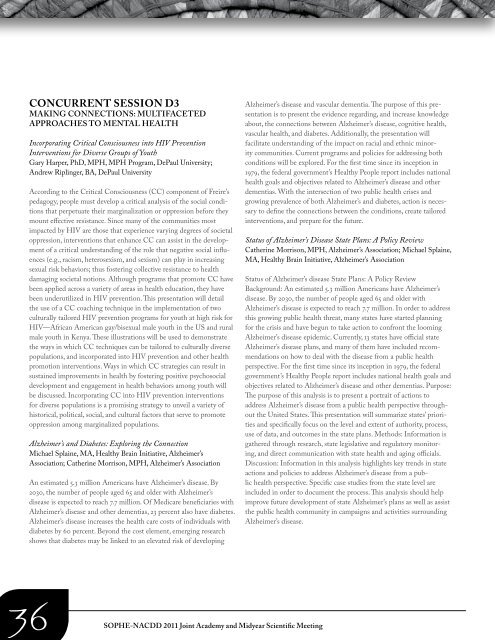to view the program - Society for Public Health Education
to view the program - Society for Public Health Education
to view the program - Society for Public Health Education
Create successful ePaper yourself
Turn your PDF publications into a flip-book with our unique Google optimized e-Paper software.
Concurrent Session D3<br />
Making Connections: Multifaceted<br />
Approaches <strong>to</strong> Mental <strong>Health</strong><br />
Incorporating Critical Consciousness in<strong>to</strong> HIV Prevention<br />
Interventions <strong>for</strong> Diverse Groups of Youth<br />
Gary Harper, PhD, MPH, MPH Program, DePaul University;<br />
Andrew Riplinger, BA, DePaul University<br />
According <strong>to</strong> <strong>the</strong> Critical Consciousness (CC) component of Freire’s<br />
pedagogy, people must develop a critical analysis of <strong>the</strong> social conditions<br />
that perpetuate <strong>the</strong>ir marginalization or oppression be<strong>for</strong>e <strong>the</strong>y<br />
mount effective resistance. Since many of <strong>the</strong> communities most<br />
impacted by HIV are those that experience varying degrees of societal<br />
oppression, interventions that enhance CC can assist in <strong>the</strong> development<br />
of a critical understanding of <strong>the</strong> role that negative social influences<br />
(e.g., racism, heterosexism, and sexism) can play in increasing<br />
sexual risk behaviors; thus fostering collective resistance <strong>to</strong> health<br />
damaging societal notions. Although <strong>program</strong>s that promote CC have<br />
been applied across a variety of areas in health education, <strong>the</strong>y have<br />
been underutilized in HIV prevention. This presentation will detail<br />
<strong>the</strong> use of a CC coaching technique in <strong>the</strong> implementation of two<br />
culturally tailored HIV prevention <strong>program</strong>s <strong>for</strong> youth at high risk <strong>for</strong><br />
HIV—African American gay/bisexual male youth in <strong>the</strong> US and rural<br />
male youth in Kenya. These illustrations will be used <strong>to</strong> demonstrate<br />
<strong>the</strong> ways in which CC techniques can be tailored <strong>to</strong> culturally diverse<br />
populations, and incorporated in<strong>to</strong> HIV prevention and o<strong>the</strong>r health<br />
promotion interventions. Ways in which CC strategies can result in<br />
sustained improvements in health by fostering positive psychosocial<br />
development and engagement in health behaviors among youth will<br />
be discussed. Incorporating CC in<strong>to</strong> HIV prevention interventions<br />
<strong>for</strong> diverse populations is a promising strategy <strong>to</strong> unveil a variety of<br />
his<strong>to</strong>rical, political, social, and cultural fac<strong>to</strong>rs that serve <strong>to</strong> promote<br />
oppression among marginalized populations.<br />
Alzheimer’s and Diabetes: Exploring <strong>the</strong> Connection<br />
Michael Splaine, MA, <strong>Health</strong>y Brain Initiative, Alzheimer’s<br />
Association; Ca<strong>the</strong>rine Morrison, MPH, Alzheimer’s Association<br />
An estimated 5.3 million Americans have Alzheimer’s disease. By<br />
2030, <strong>the</strong> number of people aged 65 and older with Alzheimer’s<br />
disease is expected <strong>to</strong> reach 7.7 million. Of Medicare beneficiaries with<br />
Alzheimer’s disease and o<strong>the</strong>r dementias, 23 percent also have diabetes.<br />
Alzheimer’s disease increases <strong>the</strong> health care costs of individuals with<br />
diabetes by 60 percent. Beyond <strong>the</strong> cost element, emerging research<br />
shows that diabetes may be linked <strong>to</strong> an elevated risk of developing<br />
Alzheimer’s disease and vascular dementia. The purpose of this presentation<br />
is <strong>to</strong> present <strong>the</strong> evidence regarding, and increase knowledge<br />
about, <strong>the</strong> connections between Alzheimer’s disease, cognitive health,<br />
vascular health, and diabetes. Additionally, <strong>the</strong> presentation will<br />
facilitate understanding of <strong>the</strong> impact on racial and ethnic minority<br />
communities. Current <strong>program</strong>s and policies <strong>for</strong> addressing both<br />
conditions will be explored. For <strong>the</strong> first time since its inception in<br />
1979, <strong>the</strong> federal government’s <strong>Health</strong>y People report includes national<br />
health goals and objectives related <strong>to</strong> Alzheimer’s disease and o<strong>the</strong>r<br />
dementias. With <strong>the</strong> intersection of two public health crises and<br />
growing prevalence of both Alzheimer’s and diabetes, action is necessary<br />
<strong>to</strong> define <strong>the</strong> connections between <strong>the</strong> conditions, create tailored<br />
interventions, and prepare <strong>for</strong> <strong>the</strong> future.<br />
Status of Alzheimer’s Disease State Plans: A Policy Re<strong>view</strong><br />
Ca<strong>the</strong>rine Morrison, MPH, Alzheimer’s Association; Michael Splaine,<br />
MA, <strong>Health</strong>y Brain Initiative, Alzheimer’s Association<br />
Status of Alzheimer’s disease State Plans: A Policy Re<strong>view</strong><br />
Background: An estimated 5.3 million Americans have Alzheimer’s<br />
disease. By 2030, <strong>the</strong> number of people aged 65 and older with<br />
Alzheimer’s disease is expected <strong>to</strong> reach 7.7 million. In order <strong>to</strong> address<br />
this growing public health threat, many states have started planning<br />
<strong>for</strong> <strong>the</strong> crisis and have begun <strong>to</strong> take action <strong>to</strong> confront <strong>the</strong> looming<br />
Alzheimer’s disease epidemic. Currently, 13 states have official state<br />
Alzheimer’s disease plans, and many of <strong>the</strong>m have included recommendations<br />
on how <strong>to</strong> deal with <strong>the</strong> disease from a public health<br />
perspective. For <strong>the</strong> first time since its inception in 1979, <strong>the</strong> federal<br />
government’s <strong>Health</strong>y People report includes national health goals and<br />
objectives related <strong>to</strong> Alzheimer’s disease and o<strong>the</strong>r dementias. Purpose:<br />
The purpose of this analysis is <strong>to</strong> present a portrait of actions <strong>to</strong><br />
address Alzheimer’s disease from a public health perspective throughout<br />
<strong>the</strong> United States. This presentation will summarize states’ priorities<br />
and specifically focus on <strong>the</strong> level and extent of authority, process,<br />
use of data, and outcomes in <strong>the</strong> state plans. Methods: In<strong>for</strong>mation is<br />
ga<strong>the</strong>red through research, state legislative and regula<strong>to</strong>ry moni<strong>to</strong>ring,<br />
and direct communication with state health and aging officials.<br />
Discussion: In<strong>for</strong>mation in this analysis highlights key trends in state<br />
actions and policies <strong>to</strong> address Alzheimer’s disease from a public<br />
health perspective. Specific case studies from <strong>the</strong> state level are<br />
included in order <strong>to</strong> document <strong>the</strong> process. This analysis should help<br />
improve future development of state Alzheimer’s plans as well as assist<br />
<strong>the</strong> public health community in campaigns and activities surrounding<br />
Alzheimer’s disease.<br />
36<br />
SOPHE-NACDD 2011 Joint Academy and Midyear Scientific Meeting

















